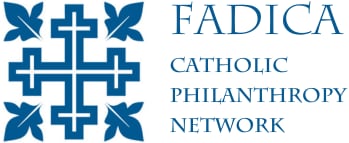Catholic Philanthropies Bring Post-Katrina Aid to New Orleans Nuns
WASHINGTON — Catholic philanthropies have delivered a big shot in the arm to eight New Orleans congregations of women religious still suffering from the massive devastation of Hurricane Katrina in 2005.
In the fall of 2006 FADICA – Foundations and Donors Interested in Catholic Activities – alerted its member foundations to the urgent needs those congregations still faced a year after Katrina.
Since then member foundations have come up with more than $4.4 million in grants to help pay the costs of cleaning and rebuilding the sisters’ schools, convents and other facilities that were destroyed or severely damaged by Katrina.
Combined requests from the religious orders total $6.3 million. Some requests cover only a fraction of the recovery costs.
“They had much more in damage than they could pay for,” said Dr. Francis J. Butler, FADICA president.
While U.S. Catholics had contributed nearly two hundred million dollars to humanitarian relief and church recovery in two national collections following Katrina, almost none of that went to the women religious in New Orleans, who suffered major losses from the hurricane.
The first emergency national collection through Catholic Charities USA was unable to assist church institutions in restoring lost facilities and infrastructure because it was designated as humanitarian relief. The second – established by the country’s bishops specifically for the institutional rebuilding the New Orleans Archdiocese and Diocese of Biloxi, Miss., went almost entirely to the critical needs to rebuild the parish, school and other facilities of those dioceses, with almost nothing allocated to the equally critical needs of religious orders.
When Katrina caused the 17th Street Canal to breach, the Congregation of Our Lady of Mount Carmel had its entire seven-acre New Orleans complex inundated with eight to ten feet of toxic water — the motherhouse, which had a pre-school called Cub Corner on the ground floor, and all the buildings of Mount Carmel Academy. These included the classrooms, a faculty residence, chapel, gymnasium, theater, fine arts center, library and a new four-story building that still carried a $6 million mortgage.
In January 2006, less than five months after Katrina, Mount Carmel was the first flood-damaged high school in New Orleans to reopen.
“We are still completing the pre-school (restoration),” Carmelite Sister Camille Anne Campbell, principal of Mount Carmel Academy, said in July 2008. “We’re still working on the sister house (the academy’s faculty residence), and the motherhouse is still under construction as well” with roof repairs and interior work not yet completed.
She added that the order just got a $250,000 grant from a FADICA member to restore their hurricane-damaged retreat house on the Gulf Coast outside New Orleans — which it plans to offer also to members of other women’s orders as a place of relaxation and spiritual renewal.
Katrina “truly altered our lifestyle,” she said. For her it meant several new jobs besides high school principal — including becoming the congregation’s chief fundraiser and a city-licensed contractor for the reconstruction of their facilities. In that capacity, using her past experience overseeing construction of new facilities she is saving the order nearly $100,000 in fees it would have had to pay to an outside contractor.
But more importantly, she said, the devastation and dislocation from Katrina taught her and her fellow nuns a new appreciation of their faith, the values of their community life and their relations with other people.
When they reopened their school in January 2006, less than six months after Katrina and more than 18 months before any public high school in the neighborhood, “people said we were beacons of hope” enabling them to return, she said.
In the wake of the catastrophe the Carmelite Sisters have discovered new ways of relating to people as “a witness to the power of faith and prayer. … That’s been a wonderful experience,” she said.
Some grants to women religious from FADICA members went to projects already completed for which the sisters had dug deeply into their own much-needed reserves in order to return quickly to New Orleans and resume their ministries.
In fact, at the sisters’ request, the first round of grants went primarily to restoring their ministries and educational and service programs, Butler said.
“Now we’re into a second round of needs. A theme that runs through the second round is housing for the sisters,” he said.
“Initially they just wanted to get their ministries and schools back in operation,” he said, but “a lack of housing is severely handicapping them.”
Butler credited Sister Sally Duffy, a Sister of Charity of Cincinnati, with the initiative that drew FADICA and the Leadership Conference of Women Religious together to form the New Orleans Recovery Project.
Sister Sally, president and CEO of her order’s SC Ministry Foundation and a board member of FADICA, said that after Katrina the LCWR – whose members represent 67,000 women religious around the nation – posted reports of the needs of New Orleans religious orders on its website. A number of orders including hers made direct contributions to some of the groups down there, but the needs exceeded the capability of contributions available from fellow religious orders.
She asked Butler to spearhead a Catholic foundation appeal and helped him arrange for leaders of two of the New Orleans women’s congregations to speak at the fall 2006 FADICA meeting, held in New Orleans in order to focus on church needs there.
Following the meeting Butler contacted School Sister of Notre Dame Carole Shinnick, LCWR executive director, about working together to enlist FADICA members in a short-term campaign to enable women religious based in New Orleans to recover their previous ministries and embark on new ones responding to the Katrina disaster.
Sister Carole said she had visited the religious communities in New Orleans and had seen how much they were doing. “Even though they were in such bad shape, they were creating ministries on the spot” to meet new post-Katrina needs, she said.
Butler and Sister Carole recruited Sister Suzanne Hall, a School Sister of Notre Dame, who was experienced in fundraising, to coordinate the recovery project and assist the congregations in writing up grant requests.
Sister Suzanne said when she went down to meet with the congregations and assess their needs, one of the things that struck her was the importance of the schools the sisters had reopened, long before any public schools returned to the city. “Many families told me directly that they returned to New Orleans because of the schooling by the sisters,” she said.
Sister Chris Perrier, treasurer of the Marianites of Holy Cross, said that despite flood damage to all their all their houses and school facilities, the members of her congregation wanted to return to New Orleans as soon as possible because “we really wanted to be a presence to the people in this area.”
Shortly after Katrina they started the Marianite Bywater Project — named after the upper Ninth Ward neighborhood of Bywater, where they live — to help impoverished residents, many of them senior citizens on fixed incomes, cope with the economic, social, psychological and spiritual after-effects of Katrina. With the neighborhood’s only senior center destroyed by Katrina, the Marianites have made the


